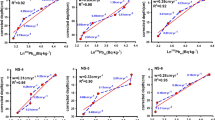Abstract
Dating lake sediment using sedimentary event is the supplement and calibration to traditional dating by radionuclide such as 210Pb and 137Cs. Based on the change of spheroidal carbonaceous particle (SCP) concentration, the age sequence of lake sediments can be deduced. It is one of the dating methods using sedimentary event. SCP is formed from combustion of fossil fuel at high temperature up to 1750°C and at a rate of heating of approaching 104 °C/s. It can be dispersed to several hundred kilometers away from its source and deposited with precipitation or dryly deposited, and kept in sediments. Compared with Cs or Pb, there is no evidence for SCP that it decays in lake sediments and is un-removable once stored except by physical disturbance because it is mainly composed of element carbon. Handy method to extract, identify and calculate has been developed. Although fossil fuel has been used early in China, combustion at high temperature started later since emergence of electricity generation. The productivity of SCP is positively related with the generated thermal power, which is reflected as the SCP concentration in lake sediments increases with the increase of generated thermal power. Therefore, reliable sediment markers from the start of the SCP record and the remarkable variation can be used for dating purpose. In China, electricity industry started from the 1950s, and rapid increase of generated power took place since 1978. Based on these time markers, SCP time sequences of lake sediment cores LH and LL-4 from Longgan Lake, the middle reach of the Yangtze River, have been established, which is comparable with the results from 137Cs and 210Pb, and has eliminated the errors of dating using 137Cs and 210Pb.
Similar content being viewed by others
References
Xiang, L., Limitation of the application of 137Cs limnochronology: A case study of 137Cs profile in Crawford lake sediment, Journal of Lake Sciences (in Chinese), 1995, 7(4): 307–313.
Abril, J. M., Constraints on the use of 137Cs as a time-marker to support CRS and SIT chronologies, Environmental Pollution, 2004, 129: 31–37.
Davis, R. B., 137Cs and 210Pb dating of sediments from soft-water lakes in New England (USA) and Scandinavia, a failure of 137Cs dating, Chem. Geol., 1984, 44: 151–185.
Yang, X. D., Wang, S. M., Shen, J. et al., Lacustrine environment responses to human activities in the past 300 years in Longganhu Lake catchment, southeast China, Science in China, Ser. D, 2002, 45(8): 709–718.
Santschi, P. H., Presley, B. J., Wade, T. L. et al., Historical contamination of PAHs, PCBs, DDTs, and heavy metals in Mississippi River Delta, Galveston Bay and Tampa Bay sediment cores, Marine Environmental Research, 2001, 52: 51–79.
Pan, Y. D., Richard, B., Human disturbance and trophic status change s in Crystal Lake, McHenry County, Illinois, USA, Journal of Paleolimnology, 1994, 17: 369–376.
Olsson, S., Regnell, J., Persson, A. et al., Sediment-chemistry response to land-use change and pollutant loading in a hypertrophic lake, Southern Sweden, Journal of Paleolimnology, 1994, 17: 275–294.
Rose, N. L., Harlock, S., Appleby, P. G., Within-basin profile variability and cross-correlation of lake sediment cores using the Spheroidal carbonaceous particle record, Journal of Paleolimnology, 1999, 21: 85–92.
Yang, H. D., Rose, N. L., Battarbee Richard W., Dating of recent catchment peats using spheroidal carbonaceous particle (SCP) concentration profiles with particular reference to Lochnagar, Scotland, The Holocene, 2001, 11(5): 593–597.
Rose, N. L., Harlock, S., Appleby, P. G. et al., The dating of recent lake sediments in the United Kingdom and Ireland using spheroidal carbonaceous particle concentration profiles, The Hollocene, 1995, 5: 328–335.
Rose, N. L., Characterisation of carbonaceous particles from lake sediments, in Proceedings of the International Symposium “Limnplogy of Mountain Lakes” Stara Lesna, Czechoslovakia, July 1–7, 1991, Hydrobiologia, 1994, 274: 127–132.
Boyle, J. F., Rose, N. L., Bennion H. et al., Environmental impacts in the Jianghan Plain: Evidence from lake sediments, Water, Air, and Soil Pollution, 1999, 112: 21–40.
Rose, N. L., A note on further refinements to a procedure for thextraction of carbonaceous fly-ash particles from sediments, Journal of Paleolimnology, 1994, 11: 201–204.
Wang, Q. Y., Coal industry in China: Development and prospect (Part A), China Coal (in Chinese), 2001, 27(1): 6–17.
Wang, Q. Y., Coal industry in China: Development and prospect (Part B), China Coal (in Chinese), 2001, 27(2): 5–18.
Yang, Q. M., Electric power construction development in China, Electric Power Construction (in Chinese), 1995, 16(9): 2–7.
Author information
Authors and Affiliations
Corresponding author
About this article
Cite this article
Yanhong, W., Sumin, W., Weilan, X. et al. Dating recent lake sediments using spheroidal carbonaceous particle (SCP). Chin.Sci.Bull. 50, 1016–1020 (2005). https://doi.org/10.1360/982004-321
Received:
Accepted:
Issue Date:
DOI: https://doi.org/10.1360/982004-321




